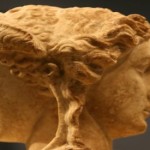We run our website the way we wished the whole internet worked: we provide high quality original content with no ads. We are funded solely by your direct support. Please consider supporting this project.

The God Who Stoops
The way that one imagines God can be thought of along the lines of a Rorschach test. That is, I submit that the way a person imagines and experiences God says at least as much about that person as it does God. The more estranged people are from God, the more their knowledge of him is obstructed and distorted. And when people yield to the Spirit, they are empowered to discern the true glory of God “in the face of Jesus Christ.”
That being said, the standard that must function as the ultimate criteria by which we assess the extent to which any conception and experience of God is accurate or inaccurate is the revelation of God in the crucified Christ.
Hence, on the one hand, to the extent that any conception and experience of God conforms to the character of God revealed on the cross, we may conclude that the Spirit has managed to break through the limited and fallen hearts and minds of people. On the other hand, to the extent that any conception or experience fails to conform to this character, we must conclude that the limited and fallen hearts and minds of people have resisted the Spirit.
Given Scripture’s repeated teaching that the people God claimed for himself in the OT were a “stiff-necked” people who continually resisted the Spirit, we ought not be surprised to discover that their conceptions and experiences of God were sometimes distorted. To the contrary, I believe we ought to rather be impressed by how frequently the Spirit succeeded in breaking through to disclose beautiful portraits of God that reflect his true character.
Knowing what we now know about God through his self-revelation on Calvary, we ought to be able to discern the true character of God in the depths of even the most seriously distorted portraits of God in the OT. For when we view them through the lens of the cross, we can see that there is something going on beneath the surface. We can discern in their depth the same humble God of self-sacrificial love stooping to bear the sin of his people that we discern on the cross.
In the OT, we can see God working within his people’s faulty Rorschach-like conceptions and experiences of him. God was bearing the sinful perspectives of his covenant people, including the horrifically violent concepts they had of him. He was accommodating the hard-heartedness of his people, stooping to their level to move his people in the right direction. The fact that God was willing to stoop in this fashion and bear the sin of his people reveals God’s true character, anticipating the revelation of God ultimately revealed on the cross.
Photo credit: jimforest via Visualhunt.com / CC BY-NC-ND
Category: General
Tags: Bible Interpretation, Cruciform Theology
Topics: Interpreting Violent Pictures and Troubling Behaviors
Related Reading

Caught Between Two Conflicting Truths
In my previous blog I tried to show that adopting a “Christocentric” approach to Scripture isn’t adequate, as evidenced by the fact that people adopting this approach often come to radically different conclusions. In fact, it seems to me that the “Christocentric” label is often close to meaningless inasmuch as it doesn’t meaningfully contrast with anything. If a “Christocentric”…

Does the Author of Hebrews Condone Capital Punishment? A Response to Paul Copan (#12)
In his critique of Crucifixion of the Warrior God (CWG), Paul Copan argues that several New Testament authors condone capital punishment as directly willed by God. The most challenging for my thesis, in my estimation, is Hebrews 10:26-29, which reads: For if we willfully persist in sin after having received the knowledge of the truth,…

Podcast: Can We Still Take Comfort in the Old Testament?
Greg considers the Old Testament revelations that are consistent with Christ crucified. http://traffic.libsyn.com/askgregboyd/Episode_0199.mp3

The Bible is Infallible NOT Inerrant
While the cruciform understanding (explained here) of the “God-breathed” nature of Scripture is in tension with the way most talk about inerrancy (See previous post on inerrancy), I do not believe it is at all incompatible with what the Church has always sought to express by affirming the “infallibility” the Scripture. The core conviction is that Scripture will…

How NOT To Be Christ-Centered: A Review of God With Us – Part I
Theologians throughout Church history have used the concept of divine accommodation to account for everything in Scripture that seemed “unworthy” of God. Whatever didn’t line up with what we know about God was seen as God accommodating his revelation to our limited and fallen framework. The trouble is, theologians have, by and large, used the…

Reading the Bible “by Faith”
The cruciform approach to reading the Bible—and specifically the culturally-conditioned and sin-stained portraits of God—requires faith on the part of the reader, which I argue in Crucifixion of the Warrior God. On one level we can discern by faith that often times God broke through the limitations and sin of the ancient authors, for we…
